
Sukarno was an Indonesian statesman, orator, revolutionary, and nationalist who was the first president of Indonesia, serving from 1945 to 1967.
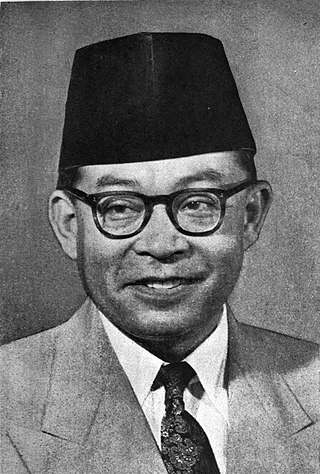
Mohammad Hatta was an Indonesian statesman, nationalist, and independence activist who served as the country's first vice president. Known as "The Proclamator", he and a number of Indonesians, including the first president of Indonesia, Sukarno, fought for the independence of Indonesia from the Netherlands. Hatta was an important figure during the Indonesian national awakening and during the national revolution, as a youth he was politically active both in the Netherlands and the Indies, which led him to be imprisoned in the Boven Digoel concentration camp for his activism, he also played a crucial part in the proclamation of Indonesian independence, being second the person to sign the declaration besides Sukarno, thus naming him as one of the founders of Indonesia.
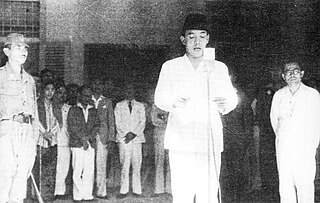
The Proclamation of Indonesian Independence was read at 10:00 on Friday, 17 August 1945 in Jakarta. The declaration marked the start of the diplomatic and armed resistance of the Indonesian National Revolution, fighting against the forces of the Netherlands and pro-Dutch civilians, until the latter officially acknowledged Indonesia's independence in 1949. The document was signed by Sukarno and Mohammad Hatta, who were appointed president and vice-president respectively the following day.

Sutan Sjahrir was an Indonesian politician, and revolutionary independence leader, who served as the first Prime Minister of Indonesia, from 1945 until 1947. Previously, he was a key Indonesian nationalist organizer in the 1930s and 1940s. Unlike some of his colleagues, he did not support the Japanese during the Japanese occupation and fought in the resistance against them. He was considered to be an idealist and an intellectual.
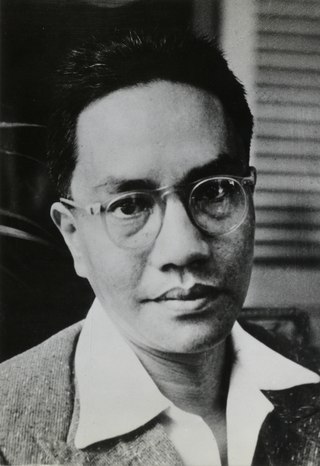
Amir Sjarifuddin Harahap was an Indonesian politician and journalist who served as the second prime minister of Indonesia from 1947 until 1948. A major leader of the left-wing during the Indonesian National Revolution, he previously served as Minister of Information from 1945 until 1946 and Minister of Defense from 1945 until 1948. Amir was born into the Sumatran aristocracy, and was educated at Leiden University. At Leiden, he became a member of the board of the Gymnasium student association in Haarlem, and was involved in the Batak student organization Jong Batak. He returned to Indonesia due to family troubles, but continued his education at the Rechts Hogeschool in Batavia.

Gerungan Saul Samuel Jacob Ratulangi was a Minahasan teacher, journalist, politician, and national hero from North Sulawesi, Indonesia. He was part of the committee that ratified the Constitution of Indonesia and served as the first Governor of Sulawesi.
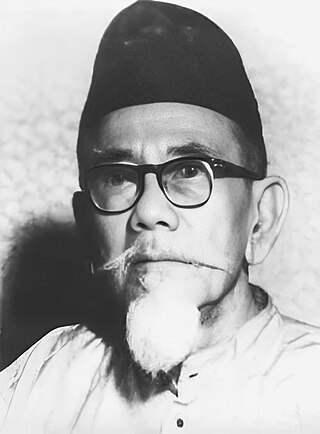
HajiAgus Salim was an Indonesian journalist, diplomat, and statesman. He served as Indonesia's Minister of Foreign Affairs between 1947 and 1949.
The League against Imperialism and Colonial Oppression was a transnational anti-imperialist organization in the interwar period. It has been referenced as in many texts as World Anti-Imperialist League or simply and confusingly under the misnomer Anti-Imperialist League.

Ki Soegondo Djojopoespito was an Indonesian politician who became the Minister of Societal Development in the Halim Cabinet.
The Association of Political Organisations of the Indonesian People was a federation of pre-war Indonesian political parties that was established to unite a range of organisations in the struggle for Indonesian independence.
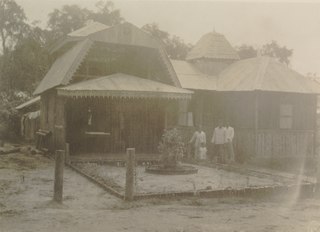
Boven-Digoel was a Dutch concentration camp for political prisoners operated in the Dutch East Indies from 1927 to 1947. It was located in a remote area on the banks of the river Digul, in what is now Boven Digoel Regency in South Papua, Indonesia. The site was chosen in 1928 for the internal exile of Indonesians implicated in the 1926 and 1927 communist uprisings in Java and Sumatra. Indonesian nationalists not associated with the Indonesian Communist Party were subsequently also sent there.

Achmad Soebardjo Djojoadisoerjo was a diplomat, an Indonesian national hero and the first foreign minister of Indonesia.

Teuku Mohammad Hasan was an Indonesian politician and national hero from Aceh, who served as the first and only governor of Sumatra from 1945 until 1948. He also served as a cabinet minister in Sjafruddin Prawiranegara's emergency cabinet and was a member of both the Senate of the United States of Indonesia (USI) and the Provisional People's Representative Council (DPRS) of the Republic of Indonesia.

"Our Struggle" was a pamphlet written late October 1945 by Indonesian independence leader Soetan Sjahrir. It was pivotal in redirecting the Indonesian national revolution.

Arnoldus Isaac Zacharias Mononutu was an Indonesian nationalist, politician, and national hero of Indonesia from North Sulawesi, who served as Minister of Information from 1949 until 1950, and the again from 1951 until 1953. He later became the first Indonesia Ambassador to China, as well as the third Rector of Hasanuddin University. A member of the Indonesian National Party, Mononutu was also involved in the struggle for Indonesia's independence. Having gained his sense of nationalism during his post-secondary studies in the Netherlands. In 2020, he was posthumously given the honorary title of National Hero of Indonesia.

Anarchism in Indonesia has its roots in the anti-colonial struggle against the Dutch Empire. It became an organized movement at the behest of Chinese anarchist immigrants, who played a key part in the development of the workers' movement in the country. The anarchist movement was suppressed, first by the Japanese occupation of the Dutch East Indies, then by the successive regimes of Sukarno and Suharto, before finally re-emerging in the 1990s.
Raden Pandji Wirasmo Notonindito, often referred to as Dr. Notonindito, was a Javanese accountant, intellectual and politician in the Dutch East Indies. He founded the short-lived Indonesian Fascist Party in 1933.

Soekaesih was a Communist Party of Indonesia activist known for being one of only a handful of female political prisoners exiled by the Netherlands government to Boven-Digoel concentration camp. After being released she traveled to the Netherlands in the late 1930s and campaigned for the camp to be shut down.

Darmawan Mangunkusumo was an Indonesian economist and engineer who served as the Minister of Welfare between 1945 and 1946, within the First and Second Sjahrir Cabinets. Before his ministerial tenure, he worked as a government economic official in the Dutch and Japanese colonial governments, and was part of the Indonesian nationalist movement since his studies in the Netherlands through Perhimpoenan Indonesia.
The Indonesian People's Movement, better known as Gerindo, was a left-wing and nationalist political party in the Dutch East Indies which existed from 1937 to 1942. It had modest goals and was largely cooperative to the colonial administration. More strongly anti-fascist than anti-colonialist, the party sought to support the colonial government in opposing fascism, especially Japanese fascism.

















